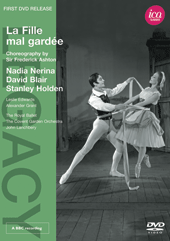 Sir Frederick Ashton’s La Fille Mal Gardee is one of the best-loved works in the Royal Ballet’s classical repertoire. This black-and-white release, recorded in 1962 (just two years after the ballet’s premiere), features the original cast of principals: Nadia Nerina as Lise, David Blair as Colas, and Stanley Holden as Widow Simone, Lise’s mother.
Sir Frederick Ashton’s La Fille Mal Gardee is one of the best-loved works in the Royal Ballet’s classical repertoire. This black-and-white release, recorded in 1962 (just two years after the ballet’s premiere), features the original cast of principals: Nadia Nerina as Lise, David Blair as Colas, and Stanley Holden as Widow Simone, Lise’s mother.
Ashton’s construction balances the humorous narrative with surprising choreographic shapes and movement sequences. This ballet is a true work of art, and producer Margaret Dale’s arrangement of the ballet for the BBC studios ensures each aspect is given due attention. The large-scale dances are given appropriate perspective, and close-up shots allow the narrative to flow smoothly and the comedy to read clearly.
Act I begins tongue-in-cheek with a dance for four hens and a rooster, setting a tone of lightness and humor for the entire ballet. We meet Nerina as the impetuous Lise, teasing her mother and always up to something. She is in love with Colas, but Widow Simone has other plans—Lise is to be wed to Alain (Alexander Grant), the bumbling and subtly hilarious son of a wealthy landowner. This act is laced throughout with smart and lively choreography for the villagers, as well as the comic “Clog Dance” for Widow Simone and four of Lise’s friends—an echo of the chickens’ dance that opened the act. After making their way to the fields for both work and play, the entire cast is chased home by a spectacular thunderstorm.
Act II opens with Simone and Lise back indoors, drying off and settling down to domestic pursuits. Lise’s mischief continues, and eventually Simone leaves on an errand. By the time she returns, Colas has sneaked into the house and hidden in Lise’s room. Lise is sent upstairs to change into her wedding dress in preparation for the arrival of Alain, his father, and the village notary. Soon the lovers are discovered, much to the dismay of the future parents-in-law! After recovering from the shock, Widow Simone relents and blesses the marriage of Lise and Colas. Act II closes with a boisterous, circular party, and as in the first act, Alain gets the last laugh.
The pas de deux in this ballet are certainly worth mentioning as highlights—none are of the usual “opening-adage-solo-solo-coda” formula. The first two make use of ribbons, one brilliantly playful, the second a nod to traditional, formal pas de deux framed by an entire corps de ballet. The third is danced through a window, and the last, reminiscent of La Sylphide or Giselle, is seamlessly integrated into the general merry-making.
This production in utterly charming and plays out like a storybook, and it’s a treat to see the original principal cast. Dance lovers will enjoy watching this piece of history!




